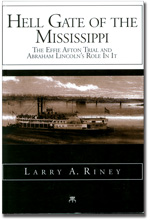Big
River Magazine Mississippi River stories and
news
|
|||||||||||||||||||||
|
|||||||||||||||||||||
A Guide to Effigy Mounds National Monument
The Effigy Mounds National Monument, just upriver from Marquette, Iowa, is a remarkable place for a number of reasons: it has the largest collection of Indian mounds, the largest collection of effigy mounds, a great little museum, amazing Mississippi River overlooks and miles of scenic hiking trails. The area is also sacred to some people. This guide is a bit of a hodgepodge, but it covers a lot of ground in its slim package. The first 30 pages gallop through 12,000 years of history before the settlers arrived. Then a timeline summarizes highlights in history from 1673, when Marquette and Joliet arrived at the Mississippi River nearby, to 2002, when the Yellow River Bridge Boardwalk Trail was completed. Then follows a history of white people discovering and trying to understand the mounds, then a history of how the monument came into being and how it came to be what it is today. A couple of pages offers ideas about the mounds from a member of the Winnebago (Ho-Chunk) Tribe of Nebraska. The final section of the book describes places and trails in the monument. Several individuals who were important to the monument and local archaeology are profiled briefly, including Ellison Orr, who explored and documented countless sites over most of his long lifetime. He and his son, Fred, conducted field studies until the elder Orr was well into his 80s. As someone who usually visits the monument at least once a year, I enjoyed the book, especially learning about the history of the Yellow River Valley. A casual visitor to the monument might wonder why people built so many mounds here — what makes this place special. The book does a good job of explaining that the monument is on the edge of a huge area stretching across southern Wisconsin that was rich with effigy and other types of mounds. The more important question might be “Why is this the largest intact group of mounds, and why were nearly all the others destroyed?” This book does a good job of answering these questions. “Today, Effigy Mounds National Monument preserves remnants of a cultural tradition of the people who built mounds of earth. Within the national monument, 206 known mounds are preserved, 31 in the shapes of animals. At one time, an estimated 10,000 mounds existed in northeast Iowa alone, today less [sic] than a thousand remain.” Top Water Women Wisdom: Voices from the Upper Mississippi
Nancy Scheibe records the first leg of her paddle down the Mississippi to celebrate her 50th birthday. This 2004 journey took the Ely, Minn., artist and her traveling companion Heather Jeske from the headwaters at Lake Itasca to Red Wing, Minn. Along the way, they were joined by numerous other canoeists and kayakers for portions of the trip, and organized gatherings with women to talk and share personal stories. The first women invited to speak at these groups were “grandmothers,” from the Native American tradition of calling any woman over 50 a grandmother, whether she has children or not. Stories from the gatherings are sprinkled throughout, while the narrative flows as a journal through the book. The reader can choose to read the stories, or just the travel journal, or go back and forth. I skipped some of the personal stories, then went back to read more later. Many of the women told stories of painful life experiences, what they had learned and how they had found personal strength. A powerful spiritual theme runs through both the grandmother stories and the river travels. Scheibe often sees messages and connections in nature, such as a bird showing them the way, a lone basking turtle reminding her that being alone is okay, a snake in the road giving her the message that taking no action can have negative results. Thankfully, she did not interpret all her animal encounters this way. I read over these parts pretty fast, as well as some of the detailed descriptions and personal experiences about the paddlers. Self-renewal, getting closer to one’s real self, community and women’s wisdom were the women's motivations for taking and sharing the journey. Their experiences with the river itself gave me a good idea what to expect if I ever think of taking such a journey. In this way, the account serves as a helpful guide. A windy crossing of Cass Lake became a little dangerous, a warning for others. Scheibe’s descriptions of campgrounds, wildlife, weather events, paddling challenges and locking through are interesting for both real and armchair Mississippi River paddlers. This September (2007), Scheibe resumed her river trip at Red Wing with another traveling partner, and planned to arrive in St. Louis mid-October. She planned gatherings along the way, as in 2004. Two more jaunts will complete the journey in New Orleans. Top
Mississippi River sandbars and islands are not exactly wild around here, but wild enough to keep an eye out for snakes and turtles and various furry, four-legged critters that may be wandering about. But when young Will Finn is washed up on an island down by Memphis he finds fierce mutant ferrets the size of golden retrievers. The island also harbors Daschell Potts, a reclusive — and probably demented — author whose claim to fame is his notoriously popular book Folderol, a philosophical and inspirational story about a duck swimming in a circle. Will makes do on the island, using flotsam that washes up on shore, including a BarcaLounger and assorted junk food. As he says, “On the Mississippi River, if you keep your eyes peeled, whatever you’re likely to need will eventually pass by.” He is overjoyed to discover Potts, his favorite author, but is aghast at the man’s missing ear, removed by a particularly nasty ferret. Trying to get a peek at what he thinks is Potts’ new manuscript, Will stumbles into trouble, but always figures something out or is rescued in the nick of time. (He’s proud of his personal motto, courtesy of his fourth-grade teacher, “Where there’s a Will there’s a way.”) It takes Will a while to figure out what kind of nefarious scheme Potts is dreaming up, involving the bloodthirsty ferrets and fast food. Richard Jennings tips his hat to Mark Twain more than a few times in this juvenile novel. Will Finn’s best buddy on the island is a friendly and helpful ferret, Jim; Huckleberry Finn and Folderol are the two books that a local town council deem worthy of destroying. Not to mention the chapter titled “Life on the Mississippi,” and the pretty, blond girl who also lands on the island and gets lost in a cave with Will. The action really gets going after Will (barely) escapes the island (Warning: SPOILER ahead) through a tunnel under the river dug out by thousands of sharp ferret teeth. He catches a ride on a turnip truck and falls off, meets a misguided federal officer in hot pursuit of rampaging parrots, and enlists the help of a former-congressman/ex-con-turned-Homeland Security agent, Pierre Narf. In an attempt to save the world, Will must pursue Potts and his school bus full of giant hungry ferrets. Yes, it’s a wacky ride, and adults will chuckle along with the younger readers for whom this book is written. Along the way, I learned a few fun facts about ferrets: they steal things; they smell bad; and they smell really bad when they are really big: “…you learn that a ferret’s smell is not a rancid stink like the monkey house at the zoo, but a rich and complex bouquet on the order of Ethiopian coffee, Honduran cigars, or Parmesano Reggiano cheese, an aroma that’s immediately identifiable, a musky essence that announces, ‘I am weasel, smell me more.’” Jennings sneaks in a plug for a previous novel, Stink City, about a boy whose family has a secret recipe for an incredibly stinky and successful catfish bait. Mmm… there’s no denying the olfactory possibilities of the Mississippi River.Top Bike and Paddle Guides Biking
Illinois Biking Iowa Paddling Iowa Paddling Southern Minnesota Paddling Southern Wisconsin All of these books suggest dozens of outdoor excursions, each of which are sketched with a clear map and detailed explanations of what to expect, points of interest and useful information, including campgrounds and rentals. They all include trips on or near the Mississippi River. To take in a pannier or canoe, you’d probably prefer to copy the pages you need, but the descriptions include enough detail to tempt you to while away a frigid afternoon daydreaming of summer adventures. Top Hell Gate of the Mississippi — The Effie Afton Trial and Abraham Lincoln’s Role in It
Hell Gate of the Mississippi is a meticulous, engaging book about the who, why and how of one of the most famous trials on the Mississippi River. In May of 1856 the Effie Afton steamboat crashed into a railroad bridge over the Mississippi. Captain Hurd, owner and pilot of the boat, sued the Railroad Bridge Company for building the bridge at a treacherous location and thereby endangering river traffic. Abraham Lincoln, a young, relatively inexperienced lawyer from Springfield, Ill., was recruited to join the legal team defending the Railroad Bridge Company. The trial was important because the privately funded bridge was the first railroad bridge to span the river, linking the expanding agricultural areas of Iowa with markets in the East. Railroads were poised to triumph over riverboat shipping, and river people up and down the Mississippi knew it. They protested the bridge before it was built. Two weeks after it was completed, the Effie Afton crashed into it, burst into flame and burned up the bridge. The steamboating community celebrated the bridge’s demise and supported Captain Hurd throughout the first, high-profile trial, which ended in a hung jury, and through succeeding attempts to win the case. Abraham Lincoln was one of several lawyers arguing the case, and gave a summary speech for the defense. He was paid $800 for his labor, not nearly as much as he was paid for other work. The author points out, however, that it was no doubt good strategy for a country lawyer with political ambitions to work for influential Chicago railroad interests. To the author’s credit, the book was far more absorbing than one might expect from a story about a long-past legal dispute. I’ve heard about the Effie Afton incident, but didn’t know why the trial was still in public memory 150 years after it happened. For my taste, though, the book exhausted me with details in places, such as an explanation of exactly where the stones for the short piers supporting the bridge spans were quarried. The story is good enough that I just wanted the author to get on with it and not slow down for such historical footnotes. Top Fifty Uncommon Birds of the Upper Midwest Watercolors by Dana Gardner, Text by Nancy Overcott; University of Iowa Press, Iowa City, Iowa, 2007, 112 pages, $34.95, hardcover. While you are holed up in a heated room under artificial light this winter, you might want to pick up this book and dream of birding days to come. The uncommon birds that are the subject of the book are uncommon because their numbers have decreased (red-headed woodpecker), or because they may be here one year and not the next (snowy owl) or because they’re just plain hard to find (Townsend’s solitaire). It’s a very satisfying book just to sit and look at. Dana Gardner’s watercolor illustrations are beautiful, evocative and stylish. Gardner paints distinctive details of each bird and its plumage, along with a few key elements of a typical place where it might be seen. A kind of silence surrounds each bird — the backgrounds are left serene and dreamy, like the wide open spaces of nature. For example, the Acadian flycatcher perches on an oak twig, from which dangle old, curled, brown oak leaves. The bird’s soft brown back and slight head crest, its white eye ring and the configuration of white bars on its black wing are all concisely portrayed. The background is a hazy blur of spring green. The text by Nancy Overcott is amiable, informative and easy to read. She tells about each bird and recounts at least one birding adventure involving it. Her friends and neighbors, and other birders are characters in these little stories, most of which take place near her home in Fillmore County, Minn., where she writes about birds for the Fillmore County Journal. The book is a companion to Gardner and Overcott’s earlier book Fifty Common Birds of the Upper Midwest, published in 2006. Top April Pulley Sayre, Illustrated by Steve Jenkins; Henry Holt and Company, LLC, New York City, 2007, 32 pages, $16.95, softcover. At first glance, vultures don’t seem a plausible subject for a book for small children. After all, they’re kind of bizarre-looking, with a preference for food that been dead awhile and therefore stinks. But Sayre tells their story in light-hearted rhymes suitable for young children.
Turn the page and there’s a gorgeous paper collage of a rotting deer carcass. This would be a great book to read to a child who lives in the Upper Mississippi River Valley, where turkey vultures soar. Top |
|||||||||||||||||||||
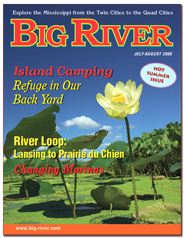


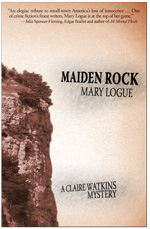
 Dennis Lenzendorf, Eastern
National, Fort Washington, Penn., 2007, 130 pages, $15.95,
paperback.
Dennis Lenzendorf, Eastern
National, Fort Washington, Penn., 2007, 130 pages, $15.95,
paperback.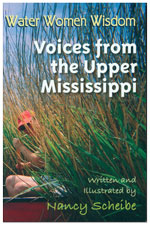 Nancy Scheibe, Singing River Publications,
Inc., Ely, Minn., 2007, 243 pages, $16.00, paperback.
Nancy Scheibe, Singing River Publications,
Inc., Ely, Minn., 2007, 243 pages, $16.00, paperback.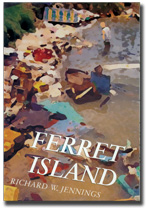
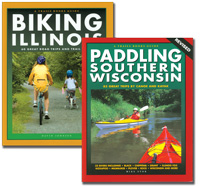 Trail Books, Madison, Wis., $19.95, paperback.
Trail Books, Madison, Wis., $19.95, paperback.